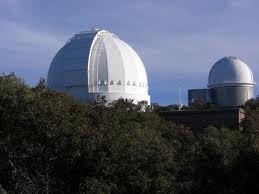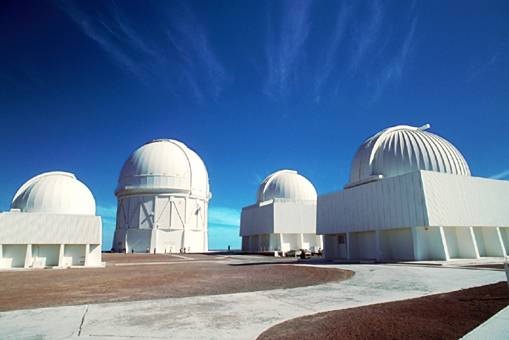July 25, 2013
Media Contact:
Dr. Katy Garmany
Deputy Press Officer
National Optical Astronomy Observatory
950 N Cherry Ave
Tucson AZ 85719 USA
+1 520-318-8526
E-mail: kgarmany@noao.edu
“The Whirlpool Galaxy (Messier 51) has been a popular night sky target for astronomers for centuries. Charles Messier first identified it in 1773 and listed it as number 51 in his catalog. To him, it looked like a faint, fuzzy object that might be a comet. William Parsons, the 3rd Earl of Rosse, used his 72-inch telescope ‘Leviathan’ to observe the Whirlpool in 1845. Since then, Messier 51 has likely been targeted by virtually every telescope in the northern hemisphere. It is found in the constellation Canes Venatici (the Hunting Dogs) and is a classic example of a spiral galaxy.

Whirlpool Galaxy (Messier 51)
Now, a new camera on the WIYN 3.5-meter telescope at Kitt Peak National Observatory has imaged the Whirlpool Galaxy anew. The wide field of the One Degree Imager (ODI) camera makes it possible to capture the entire galaxy and its companion in one pointing, something that even the Hubble Space Telescope cannot do.
Indiana University (IU) astronomy professor Katherine Rhode led this effort as part of an imaging survey of spiral and elliptical galaxies. The survey is aimed at understanding how these so-called ‘giant galaxies’ form and evolve.
‘The WIYN telescope is an ideal telescope for the survey because of its wide field and because it produces some of the sharpest, highest-quality images possible with a ground-based telescope’, explained Rhode. ‘WIYN’s 3.5-meter mirror is also very efficient at gathering light from astronomical objects, so it allows us to image faint objects, like individual star clusters within the galaxies.'”
See the full article here.
NOAO is the US national research & development center for ground-based night time astronomy. In particular, NOAO is enabling the development of the US optical-infrared (O/IR) System, an alliance of public and private observatories allied for excellence in scientific research, education and public outreach.
Our core mission is to provide public access to qualified professional researchers via peer-review to forefront scientific capabilities on telescopes operated by NOAO as well as other telescopes throughout the O/IR System. Today, these telescopes range in aperture size from 2-m to 10-m. NOAO is participating in the development of telescopes with aperture sizes of 20-m and larger as well as a unique 8-m telescope that will make a 10-year movie of the Southern sky.
In support of this mission, NOAO is engaged in programs to develop the next generation of telescopes, instruments, and software tools necessary to enable exploration and investigation through the observable Universe, from planets orbiting other stars to the most distant galaxies in the Universe.
To communicate the excitement of such world-class scientific research and technology development, NOAO has developed a nationally recognized Education and Public Outreach program. The main goals of the NOAO EPO program are to inspire young people to become explorers in science and research-based technology, and to reach out to groups and individuals who have been historically under-represented in the physics and astronomy science enterprise.
The National Optical Astronomy Observatory is proud to be a US National Node in the International Year of Astronomy, 2009.
About Our Observatories:
Kitt Peak National Observatory (KPNO)
Kitt Peak National Observatory (KPNO) has its headquarters in Tucson and operates the Mayall 4-meter, the 3.5-meter WIYN , the 2.1-meter and Coudé Feed, and the 0.9-meter telescopes on Kitt Peak Mountain, about 55 miles southwest of the city.
Cerro Tololo Inter-American Observatory (CTIO)
The Cerro Tololo Inter-American Observatory (CTIO) is located in northern Chile. CTIO operates the 4-meter, 1.5-meter, 0.9-meter, and Curtis Schmidt telescopes at this site.
The NOAO System Science Center (NSSC)
The NOAO System Science Center (NSSC) at NOAO is the gateway for the U.S. astronomical community to the International Gemini Project: twin 8.1 meter telescopes in Hawaii and Chile that provide unprecendented coverage (northern and southern skies) and details of our universe.
NOAO is managed by the Association of Universities for Research in Astronomy under a Cooperative Agreement with the National Science Foundation.




